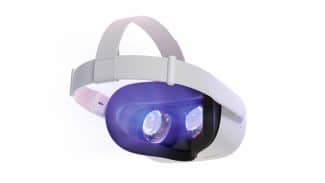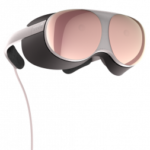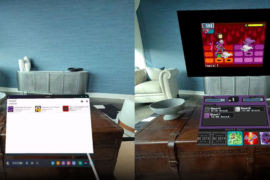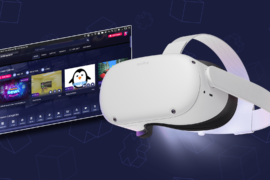Wearing glasses while also wearing a VR headset can be an incredibly uncomfortable proposition for plenty of people. In this article I’ll walk you through knowledge I’ve gathered after over five years of VR use across a multitude of devices and offer some suggestions on how to make things more tolerable and more comfortable.
[When you purchase items through links on our site, we may earn an affiliate commission from those sales.]
Wearing Glasses With VR Headsets
Since wearing glasses isn’t exactly optional for me, I’ve had to learn how to deal with cramming them inside a VR headset. I could wear contacts, but they always dry my eyes out too much and never seem to give me as much clarity as my pair of glasses do. I also spend well over 10 hours per day in front of a PC screen (most days) not to mention time in a VR headset, so the blue light protection my prescription lenses offer definitely helps curb headaches.
Long story short, I’ve considered alternatives and as of right now I prefer to just deal with wearing my glasses in VR. One of the major downsides, however, is when a VR or AR device is not designed to accommodate glasses at all — such as in the case of the Magic Leap One. Because of the way those sit on your face you can’t wear glasses and each pair needs to be designed specifically for its owner so I still haven’t had a “true” Magic Leap experience as a result. Luckily nReal is a little more spacious, but still felt a little odd.
Sidenote: This isn’t really related to wearing glasses, but definitely make sure and measure your IPD and adjust your headset accordingly. If it has a physical IPD adjuster then that’s even better. For me personally on Quest 2, I have mine set just in between the 2 and 3 slot on the slider.
In the rest of this article I’ll cover tips on how to make glasses fit more comfortably, officially recommended glasses size dimensions from Oculus, accessories you can buy to help, details on prescription lenses for VR headsets, as well as my recommendation for the best VR headsets out there to wear if you use glasses.
Tips For Making Glasses Fit Comfortably
Regardless of which VR headset you’re using, the number one thing I can recommend is that you do not put the VR headset on like most people do. In most cases, you’ll see people pull the headset down by placing the bottom of the strap at the back of their head first and then pulling it down over their eyes — like a baseball cap. But if you’re wearing glasses, this will probably smash them against your face even worse.
Instead, you should do the reverse. Press the headset against your face first, making sure your glasses fit inside and don’t smash against the lenses, and then pull the strap back over your head, more like you would put on a pair of swim goggles.
Then once you’ve got it resting on your head well I recommend sliding your glasses forward a little bit by nudging the side of the frames that stick out near your ear. Usually when putting a headset on it will press your glasses against your face but if you do this you can get a little more room to make things more comfortable.
Finally, make sure the strap of the headset on each side isn’t pinching your ears or pressing your ears against your frames (if you’re wearing a traditional strap-based headset that tightens the bulk of the headset against your forehead). It’s the same issue that happens for me if I’m wearing headphones that don’t cover my entire ear. After about 20 minutes if my ear is getting smashed against my glasses frame, it starts to really get uncomfortable so make sure something like that isn’t happening.
Alternatively if you’re using a VR headset that uses a “halo strap” design, such as the PSVR or Oculus Rift S, a lot of this advice does not apply. In fact, I would recommend putting the headset on with the headband first, like a baseball cap, since you can usually slide the headset out a bit or flip it down over your glasses.
Recommended Glasses Size And Glasses Spacers
According to official documentation from Oculus, they recommend glasses that are 142mm or less wide and 50mm or less high. Anything more than that will likely have trouble fitting in the Quest 2 and most other headsets on the market. You can see in these two images that my glasses are not super tiny, but they’re not huge either. Something like that, or smaller, is fine.
Oculus also recommends using the built-in glasses spacer with your Oculus Quest 2 and many other VR headsets also come pre-packaged with a glasses spacer. All this does is a few millimeters of extra space between your eyeballs and the lenses themselves. This is important because if your glasses rub against the lenses they could scratch them and there are few things worse than a scratched VR headset lens — you literally see it all the time and it’s extremely frustrating to deal with. The downside to using a glasses spacer is that it reduces your field of view (FOV) slightly because your eyes aren’t as close, but it’s a tradeoff worth making so you don’t ruin your headset.
Installation is easy for glasses spacers, you just pop off the default face mask, which should just click in and out easily, install the spacer, and click it back in. That’s it.
If your lenses are extra thick and still giving you trouble, you can check out the slightly larger XL Spacer for Quest 2 from VR Cover here.
Recommended Accessories To Improve Comfort
Regardless of if you are a glasses wearer or not I have two products I absolutely recommend to improve comfort of almost any VR headset out there. First and foremost, is a VR Cover facial interface upgrade. You can buy softer, far comfier, inserts that add more padding to the face plate of your VR headset and are easily wipeable for cleaning. If you enjoy any sort of active VR experience whether it be Beat Saber, Until You Fall, Supernatural, or even a lively match of boxing, you’ve probably experienced the horrendous feeling of a sweaty, wet VR headset. It’s terrible.
But if you use a VR Cover replacement, then it’s quickly wipeable for easy cleaning. Simple and effective. Plus, it eliminates the need for the glasses spacer (in my case on Quest 2) because it’s already a little bit thicker than the default pad. They make these replacements for most headsets on the market.
In addition to this, I recommend some sort of counterweight solution if you’re using a traditional headstrap VR headset. In the case of the Quest 2 there are two main options worth recommending: the VR Power battery and counterweight from Rebuff Reality, or the official Oculus Quest 2 Elite Strap with battery. In the case of the VR Power, it attaches to the back of the stock Quest 2 strap. In the case of the Elite Strap upgrade, it actually replaces the unit’s default strap for a halo strap design and adds the counterweight as well, dramatically improving comfort because it more evenly distributes the weight making it feel lighter with less pressure.
Prescription VR Lenses
I have not personally tried any prescription VR lenses myself, but I know several people that have and they all seem to love them. The idea here is that you can remove your glasses and use a VR prescription lens or lens adapter in your headset so you can still see clearly.
For me personally, I just don’t know where the copy of my prescription is at so I can’t order the right lenses and I’m too lazy to get a new one or go visit a optometrist for a new exam.
The main two brands I see recommended most often are the aptly named VR Lens Lab, a collaborative effort between VR Cover Gauss Eyewear, and WidmoVR. Again, I do not know how well either works personally, but anecdotally speaking I often see them both recommended.
Best (and Worst) VR Headsets If You Wear Glasses
After spending over five years with VR technology and nearly as long covering it professionally here at UploadVR, I definitely have some thoughts on which headsets are comfortable to wear with glasses. Since everyone’s heads are shaped differently, all glasses are different, and so on this may not be true for everyone. But after trying out almost every headset on the market, here are my favorites (for comfort) and least favorites (for comfort) that I’ve tried.
So far the best and most comfortable VR headset out there if you have glasses has been the PSVR. The halo strap design is still one of the very best even after over four years since release and the little rubbery bits that prevent too much light leaking from the nose gap rest lightly. There is next to zero face pressure with this headset and it’s very spacious inside so I never had to worry about my glasses getting smushed. Plus, you can slide the facial interface to be further or closer so that it’s just far enough away to avoid the lenses colliding. It’s quite nice.
The Rift S is next up as another halo strap design with excellent comfort, but it’s hard to recommend these days since Oculus is killing it off and shifting all focus to the Quest 2. Luckily, the Quest 2 is very affordable and if you want to spring for some extra accessories and modifications, it can be just as comfortable as well.
In terms of traditional VR headsets that strap down against your face the Reverb line from HP is very spacious and comfortable. I also appreciate the out-of-box comfort of the Quest 2, especially since you can easily make it even better.
For headsets that I absolutely hated using from a comfort perspective, the original HTC Vive was the absolute worst — ESPECIALLY with the Deluxe Audio Strap. Something about the way that connected to the sides made it extremely cramped and crammed together for my face. For the longest time it seemed like every developer at events wanted to show their games on a Vive or Vive Pro using that Deluxe strap and I hated it every single time. The original CV1 Rift was close behind it as a headset that always uncomfortably smashed down on my face and glasses.
The best way to ruin a VR experience is to have something in the real world constantly reminding you that you’re wearing a headset and it doesn’t get much worse than the headset itself distorting your glasses, blurring your vision, or pinching the sides of your face from discomfort.
Those are our tips on using VR headsets while wearing glasses. I probably forgot some advice and you probably disagree with some of this advice. Let me know any other tips you’d like to share down in the comments below!










